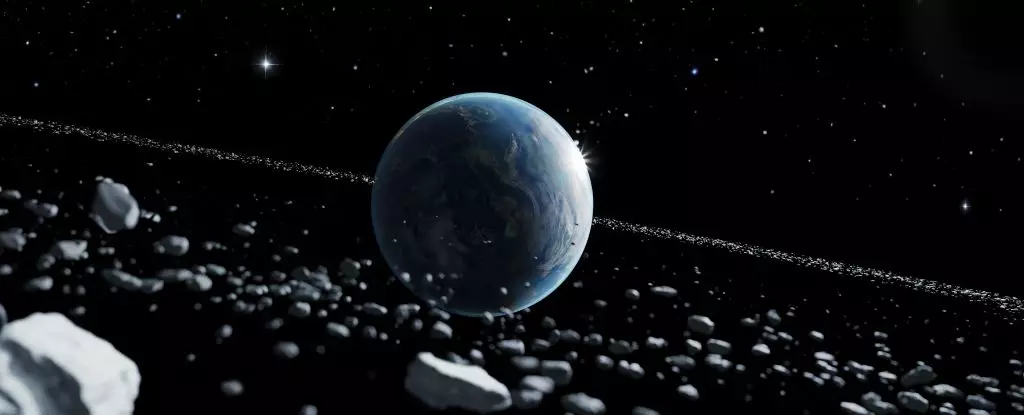

The concept that our planet might once have been adorned with a magnificent ring is not just a flight of fancy. Recent scientific investigations suggest that Earth may have hosted a temporary ring structure around 466 million years ago, during the Ordovician period. This intriguing hypothesis is rooted in meticulous detective work conducted by planetary scientist Andy Tomkins and his team at Monash University, who analyzed a phenomenon known as the Ordovician impact spike. Their findings offer a fresh perspective on Earth’s geological history and hint at a time when celestial beauty and planetary dynamics intertwined in remarkable ways.
The Ordovician impact spike refers to a significant increase in meteorite impacts that can be traced back to the Ordovician period, approximately 485 to 443 million years ago. During this era, geological activity on Earth was vibrant, with the existence of a supercontinent known as Gondwana. This geological set-up leads researchers to question why the impact events recorded from this time clustered so specifically near the equator, with a majority of the craters found within a tight latitude band. Analysis revealed that 21 major craters formed in a remarkably close temporal and spatial distribution, raising eyebrows regarding what could have caused such peculiar concentration.
Tomkins’ research proposes a compelling narrative. He suggests that an asteroid, entering Earth’s gravitational pull at an opportune angle, fragmented due to tidal forces and established an improvised ring around our planet. This theory aligns with existing observations of ring systems around other celestial bodies such as Saturn. The suggestion that a failing asteroid created a debris field encircling the Earth could illuminate why meteorite impacts were so remarkably concentrated during this specific time frame.
Earth’s gravitational influence operates under certain physical principles, one of which is known as the Roche limit. Under this gravitational constraint, a loosely bound object—like the envisioned asteroid—could break apart if it ventured too close to Earth, resulting in debris formation that persisted in orbit. The consequences of such a process could lead to a steady shower of meteorite material raining down on Earth.
The remnants of this celestial event could have left detectable traces in sedimentary rock layers corresponding to the Ordovician era. Higher concentrations of meteorite material found in these rock formations corroborate the idea that the Earth might have indeed accreted a significant amount of asteroid debris as it passed through the remnants of the ring. However, this raises important questions: What impact did these events have on life forms during this tumultuous period?
The science behind these occurrences extends beyond mere geological beauty—it touches upon the climatic conditions of the time. Towards the end of the Ordovician, the Earth was shifting into its coldest phase for half a billion years, known as a severe ice age. The interplay between the hypothesized ring and ongoing climate changes could be more than incidental. If the ring structure indeed cast shadows over parts of the planet, it could have amplified cooling effects, creating an environment ripe for evolutionary pressures.
Tomkins posits a fascinating scenario where this ring structure could have implications for biological diversity, possibly even promoting rapid evolutionary changes. The Great Ordovician Biodiversification Event, characterized by an explosion of lifeforms and evolutionary branches, might correlate with these significant changes in climate driven by the hypothetical ring’s presence.
While the implications of these findings are tantalizing, further research is essential to solidify our understanding of Earth’s ancient ring. The next phase of Tomkins’ work involves complex numerical modeling to simulate the asteroid’s disintegration and the subsequent creation and evolution of the ring. This scientific endeavor aims to elucidate the physical properties of this ring system and offer insights into the potential climatic repercussions it could have had on an evolving Earth.
The implications of this research not only stretch back into our planet’s history but also provoke exciting possibilities for the future. If the cooling effects of a similar structure could be replicated on other planets—like Venus, which suffers from extreme heat—scientists could explore innovative solutions pertaining to climate control and terraforming strategies.
While the idea of Earth once boasting its radiant ring may seem fanciful, the accompanying scientific investigations reveal deep insights into the intricacies of our planet’s history. As researchers continue to unravel the complex tale of the Ordovician impact spike, it not only enhances our understanding of past events but also could reshape how we engage with planetary science and climate intervention strategies. The intersection of celestial dynamics, evolutionary biology, and geological change fosters a richer narrative of our Earth—one that is as captivating as it is enlightening.
Rogue waves have long been a subject of fascination and terror in maritime lore. These…
As the world grapples with public health challenges, especially those posed by infectious diseases, the…
The Sombrero Galaxy, also known as Messier 104, embodies a breathtaking blend of spirals and…
In recent advances in quantum electronics, a groundbreaking discovery leveraging the concept of kink states…
In the intricate tapestry of nature, ice often exists in a delicate balance with liquid…
In an astonishing event that captured global attention, a rogue object from beyond our Solar…
This website uses cookies.